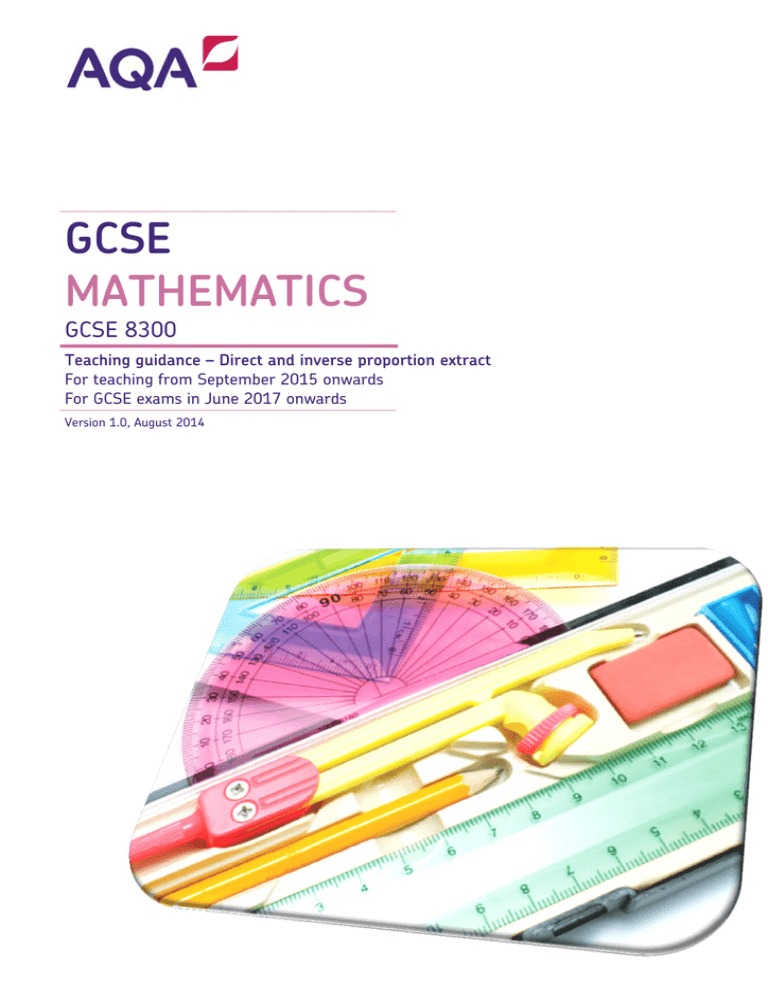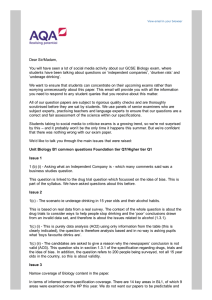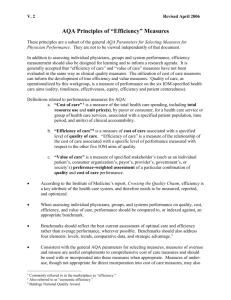
GCSE
MATHEMATICS
GCSE 8300
Teaching guidance – Direct and inverse proportion extract
For teaching from September 2015 onwards
For GCSE exams in June 2017 onwards
Version 1.0, August 2014
Our specification is published on our website (www.aqa.org.uk). We will let centres know in writing
about any changes to the specification. We will also publish changes on our website. The definitive
version of our specification will always be the one on our website, this may differ from printed
versions.
You can get further copies of this Teaching guidance from:
The GCSE Mathematics Department
AQA
Devas Street
Manchester
M15 6EX
Or, you can download a copy from our All About Maths website (http://allaboutmaths.aqa.org.uk/)
GCSE MATHEMATICS 8300 TEACHING GUIDANCE
General Information - Disclaimer
This teaching guidance will help you plan by providing examples of the
content of the specification.
It is not, in any way, intended to restrict what can be assessed in the question papers based on the
specification.
Questions will be set in a variety of formats including both familiar and unfamiliar contexts.
Examples given in this teaching guidance illustrate the type of questions which would be asked on a
question paper. However, the wording and format used in this guidance do not always represent
how questions would appear in a question paper. Questions in this guidance have not been through
the same rigorous checking process used in our question papers.
All knowledge from the Key Stage 3 and Key Stage 4 programmes of study is subsumed into the
content of the GCSE specification.
Subject content
Students can be said to have confidence and competence with mathematical content when they
can apply it flexibly to solve problems.
The expectation is that:
All students will develop confidence and competence with the content identified by standard
type
All students will be assessed on the content identified by the standard and the underlined type;
more highly attaining students will develop confidence and competence with all of this content
Only the more highly attaining students will be assessed on the content identified by bold type.
The highest attaining students will develop confidence and competence with the bold content.
The distinction between standard, underlined and bold type applies to the content statements only,
not to the assessment objectives or to the mathematical formulae in the appendix.
Understand that X is inversely proportional to Y is
equivalent to X is proportional to 1 ; interpret equations
R13
Y
that describe direct and inverse proportion
Teaching Guidance
Students should be able to:
understand that an equation of the form y = kx represents direct proportion and that k is the
constant of proportionality
understand that an equation of the form y =
k
represents inverse proportion and that k is the
x
constant of proportionality.
Examples
1
y =
5
x
Describe what happens to the value of y as the value of x increases from 1 to 10
2
Time =
distance
speed
If the distance is doubled and the speed is halved, what happens to the time?
Circle your answer.
2
3
4
1
2
1
4
For a rectangle of length l and width w,
l =
k
w
What does the constant k represent?
4
GCSE MATHEMATICS 8300 TEACHING GUIDANCE
R13h
Understand that X is inversely proportional to Y is
equivalent to X is proportional to Y1 ; construct and
interpret equations that describe direct and inverse
proportion
Teaching Guidance
Students should be able to:
understand that an equation of the form y = kx represents direct proportion and that k is the
constant of proportionality
understand that an equation of the form y =
k
represents inverse proportion and that k is the
x
constant of proportionality.
Notes
Understand that if l and w are inversely proportional, then lw = A, where A is a constant.
Examples
1
The weight (w) of a sphere is proportional to the cube of its radius (r).
When r = 5 cm, w = 500 g
Find the weight of a sphere with r = 10 cm
2
The distance, d kilometres, of the horizon from a point h metres above sea level is given by
d h
If d = 7.5 when h = 25 find
3
(a)
d when h = 40
(b)
h when d = 10
The number of beats per minute (b) a pendulum makes is inversely proportional to the square
root of its length (l).
A pendulum of length 0.16 m makes 150 beats per minute.
Work out an equation connecting b and l.
4
y is inversely proportional to x2
When x = 8, y = 2
Work out the value of y when x = 5
5
Get help and support
Visit our website for information, guidance, support and resources at aqa.org.uk/8300
You can talk directly to the Mathematical Studies subject team
E: maths@aqa.org.uk
T: 0161 957 3852
aqa.org.uk
Copyright © 2014 AQA and its licensors. All rights reserved.
AQA retains the copyright on all its publications, including specifications. However, schools and colleges registered with AQA are
permitted to copy material from this Teaching guidance for their own internal use.
AQA Education (AQA) is a registered charity ( number 1073334) and a company limited by guarantee registered in England and Wales
(company number 3644723). Our registered address is AQA, Devas Street, Manchester M15 6EX.
SP/08/14





